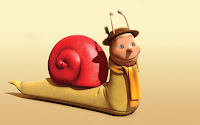I sent the above photo of a garden snail crawing along the lip of the birdbath to M. and she said: 'I didn't know they needed to drink.'
Which is not as foolish as it first sounds; for although garden snails absorb a significant amount of fluid from their food - and some directly through their skin - they do, in fact, need to drink regularly in order to maintain their water balance and not dry out.
This is not surprising when one discovers that snails are actually composed of almost 90% water (which is 20% more water than human beings, but 5% less than jellyfish).
But still, it's not often you see snails actually taking a drink ...
However, that's not to say the snail pictured was quenching its thirst; I prefer to think he was, like Narcissus, admiring his reflection in the water (even at the risk of falling in and drowning).
But then, it might be asked: Can snails see? And, even if they can see, would they pass the mirror test; i.e., are they able to recognise their own reflection?
In answer to the first question - yes, snails can see.
However, they can't see very well; they can't differentiate colours and although their eyes do possess a lens, they lack the ability to focus images. Pretty much, they can sense light and dark and work out where a source of light is coming from. But that's about it.
Still, snails do have an excellent sense of smell and can feel vibrations, changes in temperature or humidity, etc. Thus, they do okay - and have been doing okay for millions of years.
As for the second question, well, to be honest, it's doubtful that a snail would pass an MSR test. As far as scientists are aware, only a very small number of creatures can do so; apes, dolphins, elephants, magpies - i.e., the usual suspects.
But who knows what goes on in the (literally) brainless mind of a snail ...?




